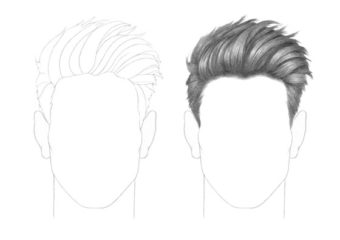How to Draw a Pepper Step by Step Tutorial
This step by step tutorial shows how to draw a pepper. It includes simple instructions along with pencil drawing examples for each step.

You can see a preview of the four major steps of the tutorial above.
Please note that the shading portion is fairly advanced. If you are a beginner looking for an easier tutorial you can try:
Egg Step by Step Basic Shading Tutorial
If you are more advanced or simply like a challenge then continue below.
Step 1 – Make a Construction Drawing

Start the drawing by making a quick sketch to “frame” the pepper. The goal is to estimate the proportions of its major parts as well as the general flow of its shape. In this case it will be narrower towards the tip and wider towards the back. The tip itself will be fairly pointy.
The main shape of a pepper is usually split into several curves which you can also proportion in this step. It can be done with just a few lines that indicate the basic size and general shape of each section.
Finally also sketch out the simplified shape of the stem. In this case it will get slightly narrower as it moves away from the pepper. It will also have a bit of a twist at the end.
Step 2 – Make a Line Drawing

Inside the construction line sketch make a line drawing of the pepper and outline the shape of it’s drop shadow.
In this setup the light is coming from the upper left of the drawing and also slightly to the front of it. This means the shadow will be to the right and slightly behind the pepper.
You can also outline the borders between the major light and dark as well as the highlights on the pepper. In this case the there will be a large highlight on the middle curve section and another at the top of the bottom section.
The tip of the stem is facing towards the light but the base will have a shadow cast on it by the main body of the pepper. This will create a sharp contrast light and shadow. The border between these can be indicated with a line as well.

Clean up the construction lines after you’re done with the line drawing as shown in the above example.
Step 3 – Apply Basic Shading

Based on the lighting conditions described earlier (light form top left and slightly to the front) the darker areas will be on the bottom and on the right.
The curved sections of the pepper can be viewed as individual shapes where each one will have its own transition from light to dark. The same goes for the stem.
To start the shading apply fairly short sets of either straight or lightly curved strokes. Try and make these in a way where they somewhat “wrap” around the various curves of the pepper. Also try and leave a tiny bit of space between the strokes to keep them visible. Afterwards add layers of strokes over the previous ones to create a crosshatch.
For different types of shading strokes see:
Shading Techniques and Stroke Types Drawing Tutorial
Leave the brighter highlight areas white. Bright and fairly sharp highlights will convey that and object (in this case the pepper) has a smooth and reflective surface.
When shading the shadow make it darker at the base (near the pepper) and lighter as it moves away from it.
As mentioned part of there will be a sharp shadow on the stem caused by the main shape of the pepper blocking some light from reaching it. The rest of the stem can be shaded similar to a cylinder where it will have a fairly smooth transition from light to dark.
For example of shading basic shapes see:
How to Shade Basic 3D Shapes Tutorial
Step 4 – Finish the Drawing

After you have the majority of the pepper filled in as in the previous step you can then refine the shading by darkening the “in shadow” areas and smoothing out the gradients.
As mentioned each section of the pepper will have its own transition from light to dark but when viewed as a whole the top curve of the pepper should be the lightest and the bottom the darkest.
When shading the shadow you can completely blend the strokes to the point of invisible and give it progressively softer/fuzzier edges as it moves away from the pepper.
Conclusion
The linear drawing of a pepper is fairly simple but the shading can be quite challenging. However shading is a very important part of making a realistic looking drawing. It can convey the lighting conditions an object is in, the type of texture it has and make an otherwise flat looking drawing appear three dimensional.
For more similar tutorials also see:
- How to Draw a Realistic Pumpkin Step by Step Tutorial
- How to Draw an Eggplant Step by Step
- How to Draw a Tomato Step by Step









